It is truly impressive to scroll through the bibliography on the extraordinary late 13th-century Madonna and Child preserved at the Museum of Santa Verdiana in Castelfiorentino, in the hills of Valdelsa. Many of the greatest art historians of all time have dealt with this work, one of the most enigmatic and problematic of the entire thirteenth century, one of the main masterpieces of the Valdelsa (as well as of Tuscany and all of Italy), and a painting by a first-rate artist: all the most important scholars specializing in the history of medieval art have offered their interpretations of this marvelous panel over and over again. It starts in the late nineteenth century with Guido Carocci, goes through the entre-deux-guerres period with Ugo Procacci, Richard Offner and Carlo Gamba, reaches the immediate post-war period with the works of Enzo Carli and Roberto Longhi, and then on with articles and writings by Pietro Toesca, Carlo Ludovico Ragghianti, Ferdinando Bologna, Paolo Dal Poggetto, Giovanni Previtali, Carlo Volpe, Miklós Boskovits, Luciano Bellosi, and on to more recent works by Angelo Tartuferi, Giovanna Ragionieri, Marco Ciatti, and Antonio Paolucci. Different points of view, different styles, different histories, but all united by a single, nagging question: who painted the Castelfiorentino panel?
Ancient documents certainly do not come to the rescue, since the discovery of the panel is a recent fact and we have no knowledge of authors from the distant past who spoke of the work. In fact, mentions of the work are recorded as early as 1890, when Guido Carocci included it, without adding, in a general catalog of the goods of the Kingdom of Italy, manuscript. It is then noted in 1910 by the travel writer Edward Hutton and by some local historians who list it among the works contained in the collegiate church of San Lorenzo in Castelfiorentino, where it stood (on a seventeenth-century altar) before its transfer to the museum: however, it is safe to assume, given its quality, that that was not its original location, and that perhaps it was not even commissioned for an essentially peripheral center like Castelfiorentino. Moreover, we can safely say that the present appearance is not what the panel originally looked like: the centering, described as “crude” by Angelo Tartuferi, is certainly a later intervention, as part of which some cuts were also made on the sides. To wait for the first publication, we have to wait until 1932, when Ugo Procacci, in issue XIV of Rivista d’Arte, points to the panel as the work of an “anonymous Florentine strongly influenced by Sienese art,” bringing it close to the celebrated Madonna di Crevole by Duccio di Buoninsegna (Siena, c. 1255 - c. 1319), preserved today in the Museo dell’Opera del Duomo in Siena. And indeed there are many similarities.
To grasp them, it is necessary to take a closer look at the Castelfiorentino panel. The Virgin, wrapped in her traditional maphorion, the blue mantle fitted with a veil to cover her head, turns a wicked glance at the viewer as she holds the Child Jesus in her arms, who is wiggling kicking and tenderly bringing one hand close to his mother’s face to caress her. This vivacity of the Child represents an important novelty, capable of giving the table a turn in a naturalistic sense, for a more truthful rendering of the affections. The maphorion is enlivened by the chrysographies (i.e., the golden streaks, used to emphasize the folds of the drapery) that harken back to the Byzantine tradition, and is decorated with a golden border: the refinement of such details fits well with thehighly lyrical, almost poignant atmosphere that the painting manages to evoke. “Looking at it closely,” wrote Antonio Paolucci, who has given us one of the densest descriptions of the Madonna and Child, “you realize that that little painting has a grim, melancholy, disjointed grandeur of its own. Just look at the Child so intrusive, so vital, so full-bodied. He really does not seem to want to be in the painting, to be cramped in the albeit spacious niche that the Mother has prepared for him, holding him in her arms. And then, in the Christ’s tunic, here are the sharp undercuts that are already the drapery system in the assisiated stories of Isaac. Here is the stroke of light that brings out the knee beneath the cloth, to emphasize, not without a certain brutality, the divine child’s divine wrenching. It is the discovery of the real that breaks through the hard, beaming crust of the Byzantine style. It is the Greek that is fading into the Latin of the figurative language of modern Italy, according to the celebrated image of Cennino and Vasari.”
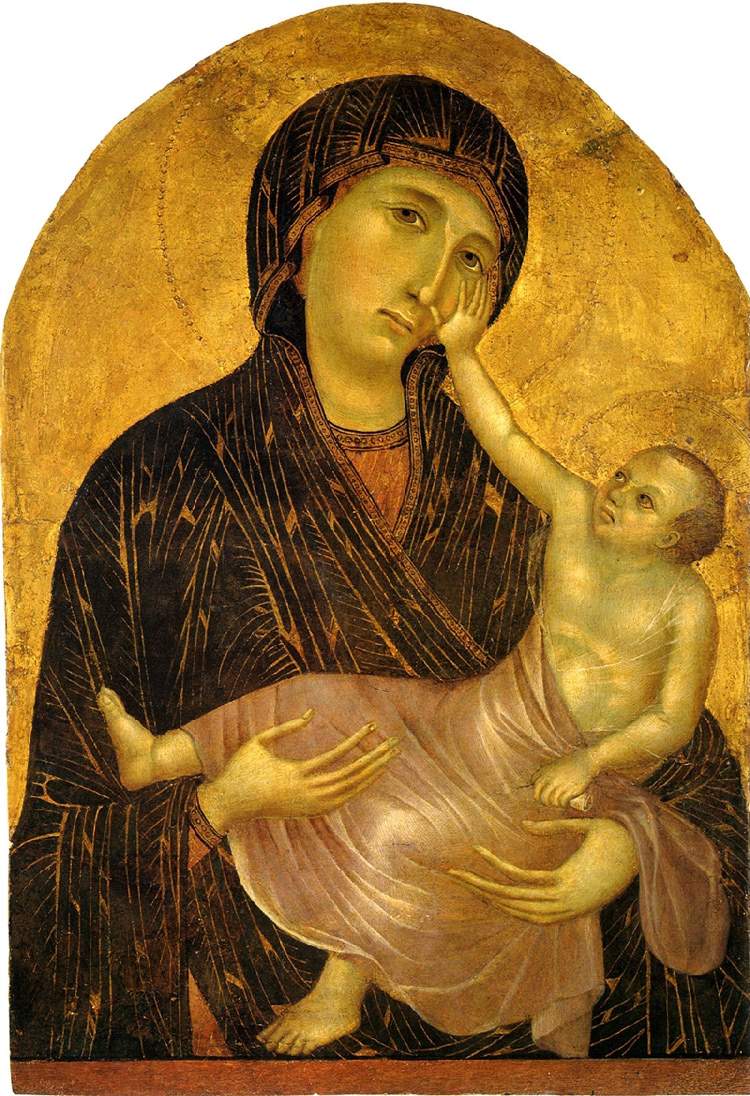 |
| Attributed to Cimabue, Madonna and Child (ca. 1285; tempera on panel, 68 x 46.3 cm; Castelfiorentino, Museo di Santa Verdiana) |
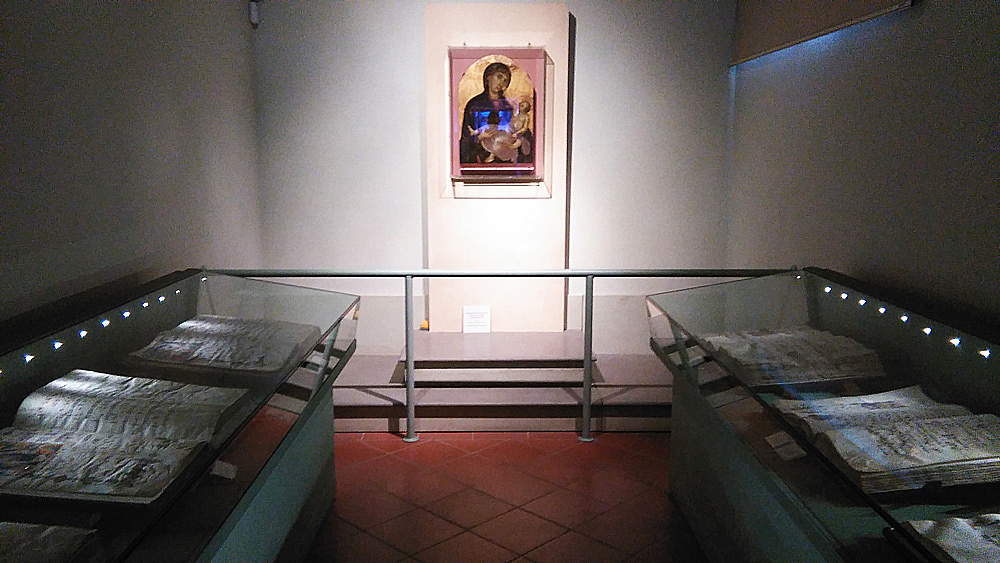 |
| The Castelfiorentino Madonna at the end of the corridor in the Museo di Santa Verdiana. Ph. Credit Finestre Sull’Arte |
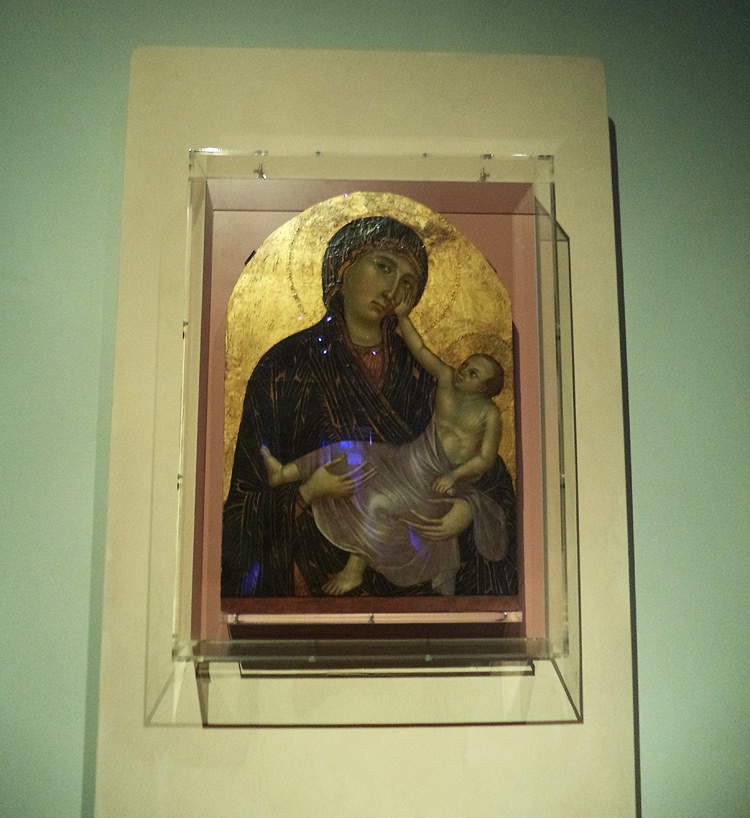 |
| The Madonna of Castelfiorentino in her shrine. Ph. Credit Finestre Sull’Arte |
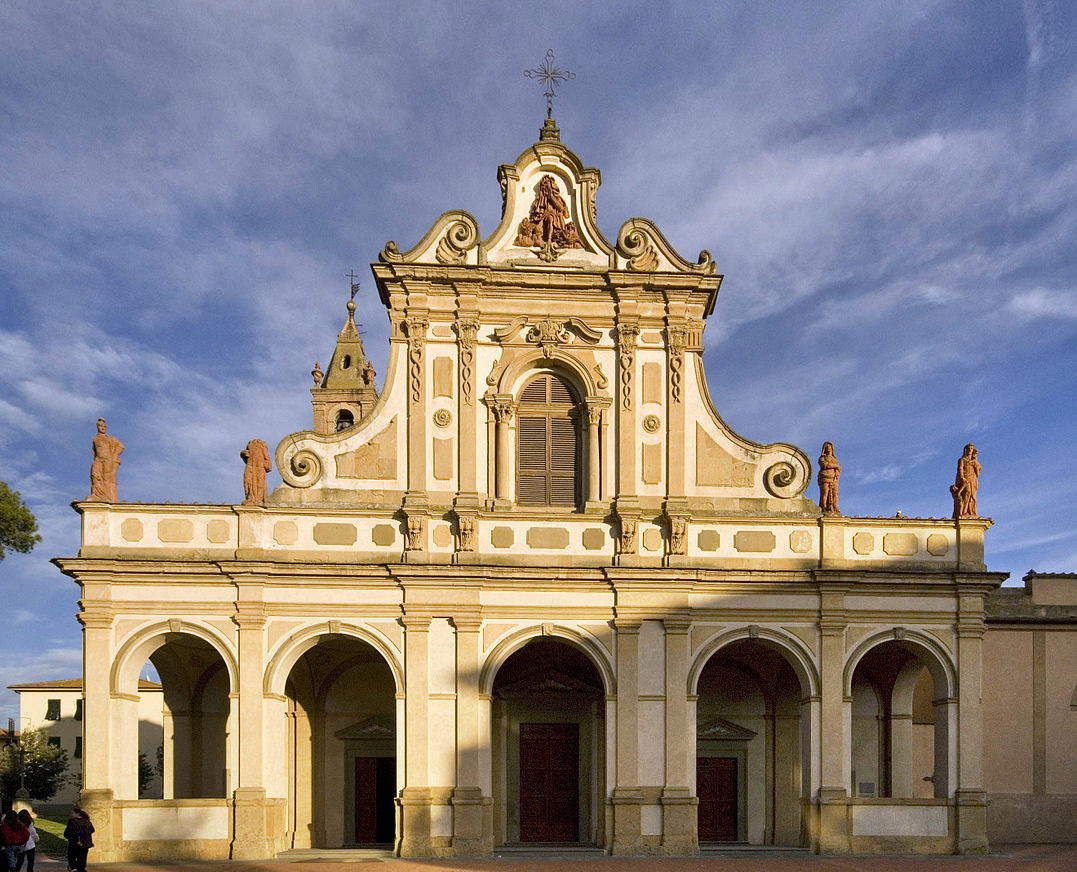 |
| The Sanctuary of Santa Verdiana in Castelfiorentino, the entrance to the Museum is on the right. Ph. Credit |
Paolucci’s description, moreover, adds some important elements that introduce some of the more recent research on the Madonna and Child of Castelfiorentino. It is necessary, however, to go in order and return to Procacci, who saw affinities with Duccio di Buoninsegna’s Madonna di Crevole. The latter is one of the most important paintings by the great Sienese artist: it is a work rooted inByzantine art, it is a panel in which Duccio’s finesse touches its peaks, and it is a work that, with the Madonna of Castelfiorentino, probably shares the prototype, since pose and gestures are similar. Here, too, we have a Madonna who turns the palm of her right hand upward (although the author of the Madonna of Castelfiorentino, in a way, “humanizes” the gesture by making the hand now serve no longer only to point to the Child, but also to support his right leg), we have a Jesus extending a hand toward his mother, we have the same gaze imbued with melancholy, not at all dispelled by the preciousness of Duccio’s linearism. For Procacci, the Madonna of Castelfiorentino was a free copy of the Madonna of Crevole, executed by an anonymous painter, whom the Tuscan art historian baptized as the “Master of Castelfiorentino.” It came only in 1933, thanks to Carlo Gamba, that the first attribution was made to the artist with whom, except for a few discordant voices, the work would later be most often associated, namely Cimabue (real name Cenni di Pepo, Florence, c. 1240 - Pisa, 1302). This is how the great scholar spoke of it: "the Castelfiorentino Madonna seems at first glance to belong to that group of Madonnas so studied and so controversial between Cimabue and Duccio that gravitate around the Pala Rucellai. But while some of these have an expression of sorrowful, wandering gentleness and their muscularless Children stand as if suspended in the air, our Madonna fixes her gaze deeply into that of the Orante and her Child has a volume, a weight, a strength that heralds a new science of dynamic modeling and a realistic dramatic power worthy of the great innovator Cimabue."
In short: the consistency of the volumetries of the two Castelfiorentino figures, according to Gamba, was compatible with that of Cimabue’s known figures. It was an opinion that had a vast following: for Volpe the panel would reveal a “complete autograph presence of Cimabue,” and scholars of the caliber of Ragghianti and Boskovits also assigned it to the sole hand of the great Florentine artist. There is no doubt that the characters are strong and energetic, as in Cimabue’s works: think of the Majesty once in San Francesco in Pisa and now in the Louvre, where it arrived following the Napoleonic spoliations (Tartuferi chronologically placed the Castelfiorentino Madonna in a period later than the Louvre Majesty, a work that Cimabue made around 1290). Yet, beyond the eminently Cimabuesque elements, the panel has too many affinities with Duccio’s style, to which “the poignant melancholy, the elegance of the refined colors and the sweet linearism” (Rosanna Caterina Proto Pisani) come close. Thus, there were authors who thought they were dealing with a work by Duccio or one of his followers: these include Curt H. Weigelt, who in 1930 assigned the Madonna of Castelfiorentino to Duccio himself, or Richard Offner, who in 1933 spoke of a work of the school of Duccio, and again Cesare Brandi, according to whom the author was an unidentified Duccioesque painter, and Pietro Toesca, who proposed for the work the name of the Master of the Rucellai Madonna (that is, the author, created by him, who in his opinion would have painted the very famous Rucellai Madonna, today unanimously assigned to Duccio).
But what if the work was a collaboration between the two great artists? A work that Cimabue and Duccio executed by four hands? It was Roberto Longhi who had this intuition in 1948, stating that the work seems to be a sign of a “joint collaboration” by Duccio “in the house of Cimabue,” and other scholars thus moved in the wake traced by the great Piedmontese art historian: among the first was Ferdinando Bologna, who in 1960 pointed to the work as having been executed by Duccio from a drawing by Cimabue (and perhaps even with active help from the latter, who would have put his hand especially to the figure of the Child, so foreign to Duccio’s painting that another name had to be necessarily called in). It is, moreover, well known that many art historians (Longhi in the lead) think that Duccio was a pupil of Cimabue (“almost created by Cimabue,” Longhi went so far as to speculate): a position that is difficult to undermine, and which would therefore make credible the hypothesis of a collaboration between the two in the realization of the Castelfiorentino panel. However, others later returned to leaning toward the name of Cimabue, a Cimabue who nonetheless measures up to Duccio’s painting and thus welcomes Duccioesque elements into his panel: this is the case with Luciano Bellosi, who nonetheless hypothesizes another collaboration, adding a further, exceedingly fascinating element to the story of the painting.
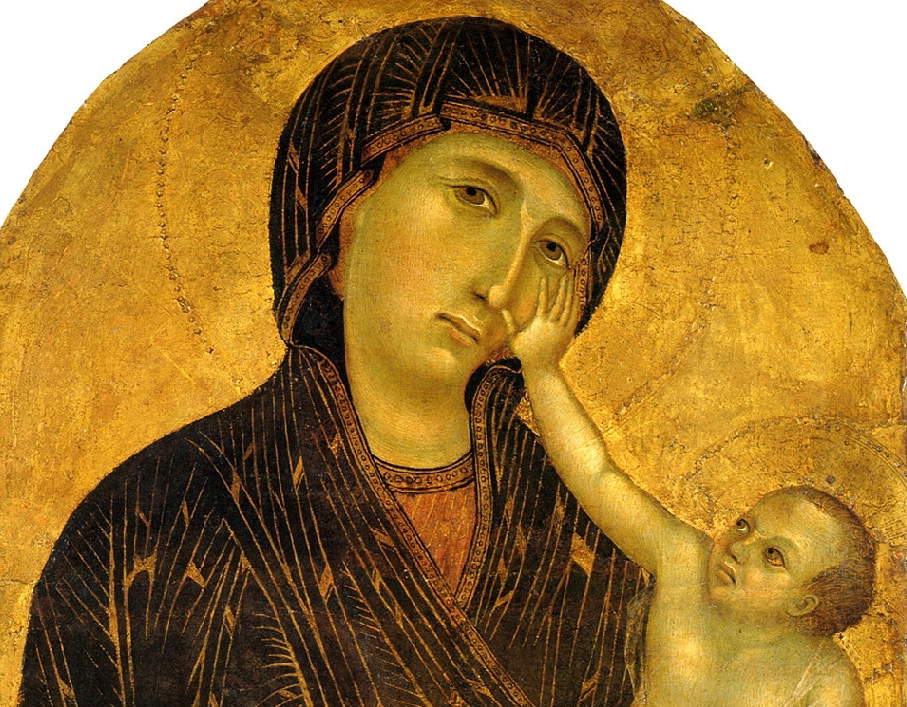 |
| The faces of the Madonna and Child in the Madonna of Castelfiorentino |
 |
| Detail of the chrysographs |
 |
| Duccio di Buoninsegna, Madonna di Crevole (1283-1284; tempera and gold on panel, 89 x 60 cm; Siena, Museo dell’Opera del Duomo) |
And it is here that we can link back to Antonio Paolucci’s description. The scholar was referring to the Stories of Isaac in the Upper Basilica of St. Francis in Assisi, in reference to the figure of the Infant Jesus. In fact, the first person to insistently link the Child to the frescoes in the Assisi worksite was, in 1985, Luciano Bellosi himself. The Florentine art historian, citing a cue from Ferdinando Bologna who related the Child to the putti of the vault of the Doctors of Assisi (attributing the latter to Duccio di Buoninsegna: an opinion with which Bellosi disagreed, believing that the geniuses of the vault were to be assigned to Giotto and workshop), wrote one of the most interesting pages on the Madonna of Castelfiorentino. In fact, there are elements in the figure of Jesus that would hint at the intervention of an artist foreign as much to the ways of Cimabue as to those of Duccio di Buoninsegna: a new artist, an artist able to “transcend” Byzantine language into a new grammar. A modern artist, for whom Bellosi proposed a high-sounding name: Giotto (Vespignano, 1267 - Florence, 1337). In his most famous book(Giotto’s Sheep), Bellosi wrote that "the Castelfiorentino Madonna, with its prelude to the painting by voluminous overhangs that will characterize the Stories of Isaac and the sequel to the frescoes in the Upper Basilica of Assisi, stands for the possibility of a new, burning presence alongside the old Cimabue and the young Duccio [...]. Giotto was the one who raised the problem of the representation of space to the highest level in the entire fourteenth century. Until Masaccio, no one ever behaved more rigorously and consistently than he did toward this new aspect of painting.“ There would be some details that would suggest that Giotto intervened in the figure of the Child in the Valdelsa Madonna: the little one’s robe is reminiscent of the bed sheet (”with sharp, taut undercut folds and shaped by a kind of lustrous, metallic halo in the area where the swelling of the mattress underneath emerges") on which Isaac is lying in the scene in which Abraham’s son rejects Esau, and similarly reminiscent of the Castelfiorentino Madonna are the highlights that, in the Stories of St. Francis, the author used to mark the protruding portions of the fabrics (and which also in the Castelfiorentino panel hint that there is a living body, a consistent physicality, beneath that veil). And then there are the putti of the doctors’ vault, to whom the “Child is almost superimposable” (so Giovanna Ragionieri).
Bellosi would return to these arguments several times: in a 2003 essay, he reiterated that what made him believe that the Child of the Madonna of Castelfiorentino was the result of an intervention by the “very young” Giotto were, on the one hand, the drapery with sharp undercut folds and, on the other, "its character of a somewhat metallic luster that indicates the overhang of the leg, as is also seen in the Stories of St. Francis in Assisi (for example, in the garment of St. Francis’ father in the Renunciation of the Assets)." Again, in the volume of the Dossier d’Art series that Bellosi wrote together with Giovanna Ragionieri and which was published in 2003, we read of the “possibility that the energetic Child was executed even by the very young Giotto.” Bellosi’s idea was scrutinized by later critics with some caution: Boskovits, in 2001, wrote that the hypothesis of Giotto’s participation “may leave one perplexed,” but he acknowledged that the drapery of the Child was, without a shadow of a doubt, similar to the drapery we find in the oldest Assisian works attributed to Giotto’s hand. And even for Boskovits the Castelfiorentino Madonna could suggest “at least close contacts between Cimabue and Giotto.” Not of the same opinion is Angelo Tartuferi, author of the most recent papers on the Madonna of Castelfiorentino: in 2004, in the file on the painting included in the catalog of the exhibition L’arte a Firenze nell’età di Dante, he argued that the hypothesis of an intervention by the young Giotto is “not sufficiently supported from a stylistic point of view.” A position reiterated in a 2014 essay, where Tartuferi states that those of the Child are “draperies of Arnolfo’s taste, which are moreover found in many Umbro-Latium paintings on panel and in fresco at the end of the 13th century”: the latter are described as “one of the most common stylistic features of the new pictorial language that was becoming established in central Italy: in a particular way in the decorative worksite of the Upper Basilica of St. Francis in Assisi, but also in Rome and Lazio, in Florence and in the other centers of Tuscany.”
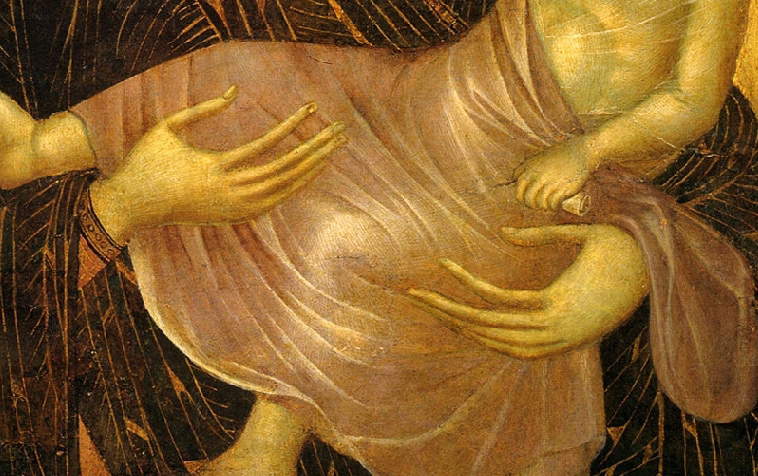 |
| Madonna of Castelfiorentino, detail of the drapery |
 |
| Master of the Stories of Isaac (Giotto?), Isaac Rejects Esau (ca. 1290-1295; fresco, 300 x 300 cm; Assisi, Upper Basilica of St. Francis) |
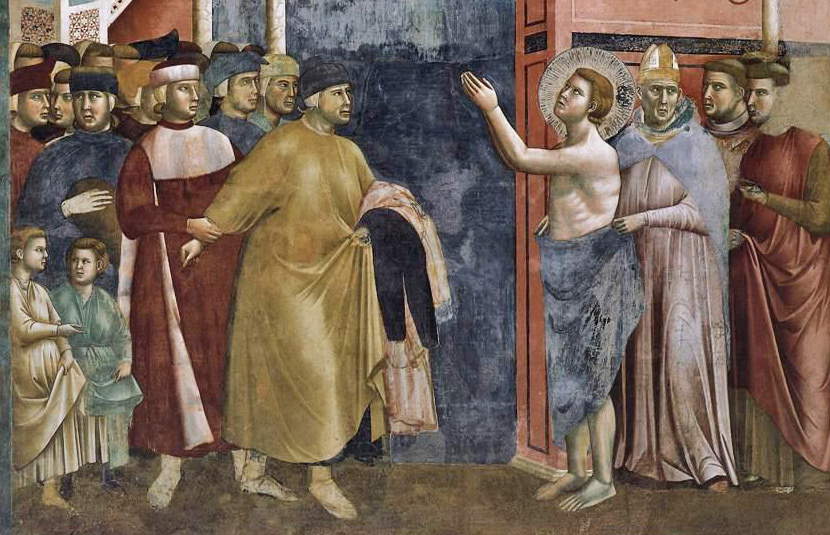 |
| Attributed to Giotto, St. Francis Renounces His Possessions (1292-1296; fresco, 230 x 270 cm; Assisi, Upper Basilica of St. Francis) |
 |
| Detail of the Child in the Madonna of Castelfiorentino |
 |
| Master of the Stories of Isaac (Giotto?), Vault of the Doctors of the Church (ca. 1290-1295; fresco; Assisi, Upper Basilica of St. Francis) |
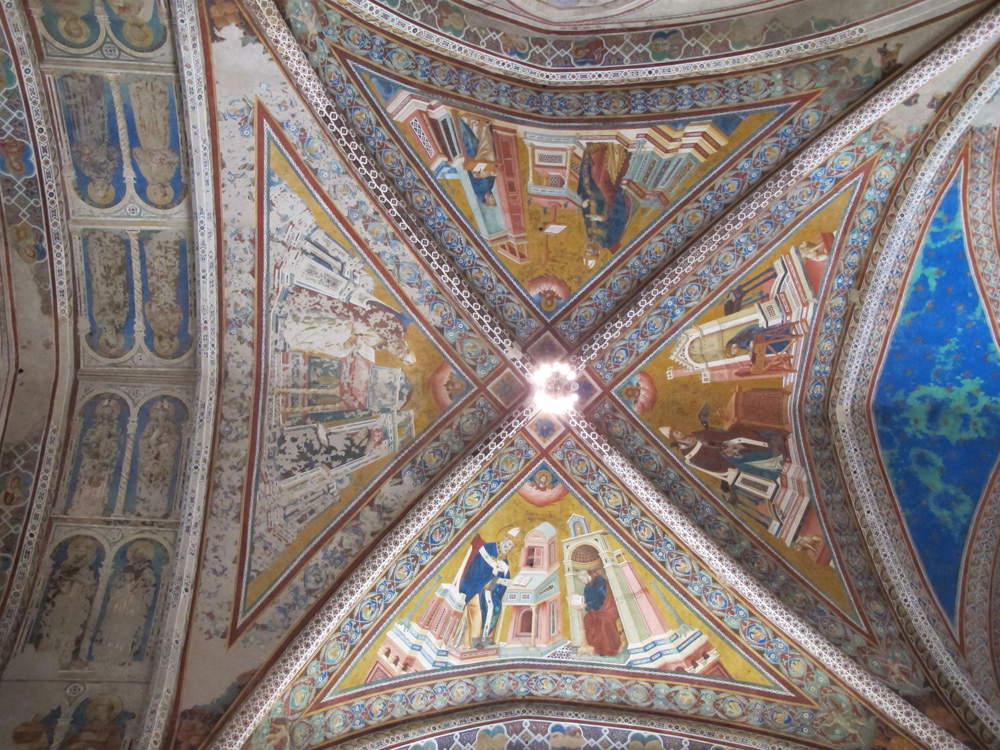 |
| Detail of one of the putti in the Vault of the Doctors |
Tartuferi, in both papers, reiterated the complete Cimabuesque autography of the Castelfiorentino Madonna, and his are the most recent contributions on the subject. Issue closed? Far from it, also because there are no predominant opinions: the position perhaps most followed in recent times is that the work is the result of the inspiration of a Cimabue open, however, to various external suggestions. And this is also the official position of the Museo di Santa Verdiana, where it is possible to read Cimabue’s name alone in the caption accompanying the panel. However, regardless of who is the author or who participated in the undertaking, all agree on one point: the Madonna and Child of Castelfiorentino is one of the most wonderfully attractive works of that period so important to the history of art as a whole. The Virgin’s sweetness veiled in foreboding sadness, the Child’s delicate gesture as she laps her mother’s face with her small, almost uncertain hand as if to comfort her, her present physicality, flesh standing out from the gold background and swelling alive with the sharp curves of the panel that envelop her: elements that led the aforementioned Paolucci to speak of a “hit parade Castelfiorentino” because of the presence of this illustrious guest of his, the “leading” image (so always Paolucci) of the Museum of Santa Verdiana, which had opened its doors to the public shortly before the scholar wrote about it.
It is fair to imagine that the Madonna of Castelfiorentino, in addition to arousing wonder in those who go to the Museum of Santa Verdiana and find it displayed, solitary, on the back wall of a narrow corridor on whose sides ancient illuminated manuscripts are exhibited, is destined to cause much discussion for a long time to come, not least because a firm critical positioning of the painting is still lacking, and above all because this work represents a fundamental junction in all medieval art. It is a crucial work because it is the place where three worlds meet: the one still Byzantine but with substantial volumes opening to the new, the one of the precious Sienese delicacies, and the one of the Latin language glimpsed on the horizon. In short: a modern work, speaking Florentine with some Sienese inflection, but employing some words of a fledgling jargon.
Reference bibliography
Warning: the translation into English of the original Italian article was created using automatic tools. We undertake to review all articles, but we do not guarantee the total absence of inaccuracies in the translation due to the program. You can find the original by clicking on the ITA button. If you find any mistake,please contact us.